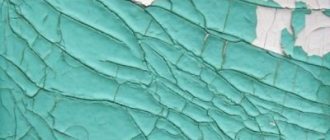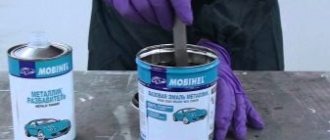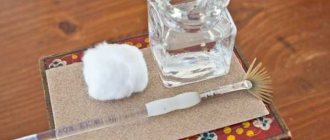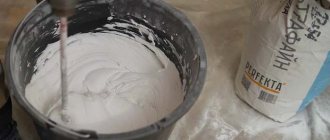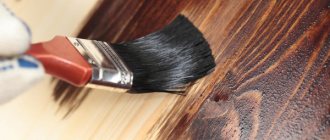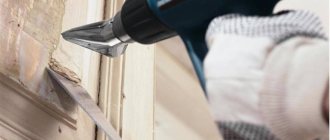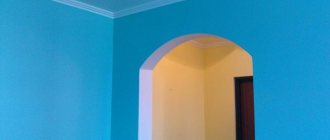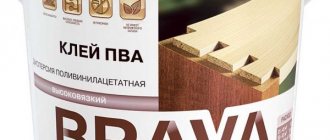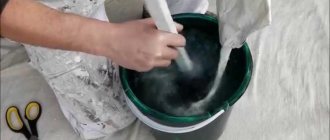Many users ask how to properly dilute water-based paint. This question comes up quite often. Your correct choice will guarantee a high-quality final result, as well as the durability of this coating. This way you will certainly avoid all the complications that may await you during construction work.
When to dilute
A composition whose component is water is called a water emulsion. If you apply the solution to the surface, you will notice that almost all the liquid quickly evaporates. The material gets its properties thanks to special fillers, which create a painted surface.
The protective layer can be obtained after a short period of time, after complete drying. The duration of this process also depends on the material on which it is applied.
Modern hardware stores offer a wide range of water-based paints. When choosing, it is better to focus on brands of well-known manufacturers who value their name and ensure the quality of their products.
Thick paint
If you opened a jar, and inside you saw a thickened composition or it was difficult to mix. In these cases, solvents must be used. But you should not overdo it, because then the composition will begin to flow, forming smudges. The protective layer will become thinner and will not be durable, and performance characteristics will sharply decrease.
Difficult to apply
Excessive density can be determined by a significant amount of the mixture that remains on the surface during painting. There are basically two methods of applying paint.
The first option is to use all kinds of brushes or construction rollers. In this case, the structure of the mixture should be sufficiently viscous. This will make it easier to manually process the ceiling or wall covering. The composition will not drain and will lay down in an even layer. If the paint is too liquid, it will be extremely difficult to apply.
The second option is spray guns or spray guns, which can be manual or electric. Using such devices, you can work even on very large areas. They will also make the whole process much easier for you and the paint will lay down perfectly evenly. A special feature of the tool is that it sprays the composition through a special nozzle under high pressure. That is why it is necessary to use a liquid consistency for devices. The dosage depends on the selected instrument model.
Violation of the shelf life
The composition will have to be diluted if the storage terms or conditions were violated. This can happen if you open a jar and then close it poorly. After a while, all dried material will be unusable. But sometimes it can be restored. To do this, you need to use special solvents, which we will discuss below. You can also dissolve the paint using PVA glue. But this is a rather expensive method.
Sometimes, after opening the can, it is discovered that the composition is very liquid. In this case, you can let it sit open for a while, without a lid, so that the excess liquid evaporates.
Adding a special hardener can also be a way out.
What types of paints are there?
Paints are produced based on different materials. Depending on the main binding component, coatings are classified into the following types:
- latex;
- acrylic;
- silicone;
- alkyd;
- oil
Latex paint Parade Professional E3 Pro'Latex3 washable matte
Latex
The main component is latex polymer. Apply to plaster or wallpaper. But it cannot be used on a metal surface. It has no odor and dries quickly. A vulnerable property is low resistance to temperature changes.
Alkyd
An alkyd varnish coating forms a protective layer on the surface. The drying process occurs due to oxidation. It is characterized by wear resistance and high hydrophobicity. The material can be used to paint metal to prevent corrosion. The downside is that it is waterproof, which does not allow the treated surface to breathe.
Acrylic
The composition based on acrylic resins is highly wear-resistant. Suitable for interior use, including wet areas. The material dries quickly and has no odor. Certain types are used for facades.
Oily
The long-drying material is used mainly for outdoor work. The solvent is drying oil or oil. The coating can be applied to wood, concrete, plaster, and metal. The product is characterized by high resistance to moisture, aggressive environments and other adverse factors. The price of paint is affordable. A significant disadvantage is the presence of toxic substances in the composition.
Silicone
Coatings are made on the basis of silicone resins. Suitable solvents are water and water-dispersed removers. After application, it forms a thin film on the surface that is capable of allowing air to pass through. Due to its moisture resistance, it is used for interior work and painting facades. The disadvantage is the high cost.
How to use water correctly
The main key to success is the choice of the most suitable thinner. Completely different substances are used for the process. Most often, ordinary water is used. This is the basis of this product.
If you have chosen water as a diluent, then you need to know exactly what parameters it must meet:
- First of all, you need to pay close attention to temperature readings . Liquid at room temperature is most suitable. If it is necessary to dilute paint for outdoor work, then the temperature of the liquid should be slightly higher than the ambient temperature. It is worth remembering that in hot weather it is necessary to add less liquid: the composition thickens more at low temperatures.
- It is best to dilute with distilled water . It is not necessary to buy such a liquid; you can get it at home; there are many ways to do this. The most popular method of purifying water is boiling it. After this, the liquid should settle.
You can not only make distilled water yourself, but also buy it at any hardware store. You can also buy this type of water at a pharmacy.
On the Internet you can find advice that it is better to dilute using all kinds of solvents. Similar compositions are often used for oil paint. It is worth noting that this absolutely cannot be done. This is completely wrong. If you add oil paint thinner, the mixture will simply curdle. And the worst thing is that such a reaction will not happen immediately. Cleaning the walls will take a long and painful time.
Is it necessary to wash off the old paint layer?
The answer to the question of whether the old finish needs to be removed depends on several factors. If the paint adheres firmly, does not come off the wall and does not bubble, it does not need to be removed.
A fresh coat can be applied to a previously painted surface, but it must be cleaned before doing so:
- wipe off the dust;
- degrease greasy areas with acetone, solvent or white spirit;
- Wash off existing contaminants with any detergent;
- dry;
- Apply a coat of primer and let it dry completely.
These measures will improve the adhesion of the old layer to the new paint and varnish material and ensure durability of the coating. But sometimes you can’t do without removing the previous finish.
When carrying out major repairs, the old layer of paint must be removed.
It is necessary to remove a layer of paint and varnish material in the following cases:
- A major renovation of the premises is planned.
- Blisters, bubbles, peeling areas, cracks and traces of mechanical damage have appeared on the surface of the walls or ceiling.
- The room will be repainted in a lighter shade or a different color that sharply contrasts with the previous paint job.
- Old and new paints and varnishes are incompatible.
Before you begin to clean the walls and ceiling of the previous decorative coating, you need to prepare working tools, available materials and the room itself in which the repair will be carried out.
Basic proportions
If you are doing the work yourself and for the first time, then you may have some difficulties. It is especially difficult to calculate proportions. First of all, you need to look for specific proportions on the label, and only then test the consistency on a test plot and make adjustments if necessary.
Features of the composition
Water-based paint is a special emulsion based on particles of polymer origin. These components do not dissolve in water because they form a very dense film. As a result, the surface treated with water-based emulsion is smooth and even.
Its composition is rich in various elements:
- latex;
- thickener;
- fillers;
- antiseptic;
- additional components.
The scope of application of the material directly affects what elements will be added to its composition. To obtain a snow-white coating, manufacturers often use sodium dioxide. If we are talking about cheap material, then this element is replaced with chalk.
In order for this type of paint to become thick, it is worth using a thickener. Glue is often added to coatings. Demineralized water became the basis for this paint because it makes it possible to achieve a better consistency of the material.
This type of paint has the following technical characteristics:
- Viscosity. This parameter of the material is measured by a special device - a viscometer.
- The average specific gravity of the material is 135 kilograms per liter.
- The coating will dry for a certain time, which depends on the temperature conditions inside the room. The optimal option is about +20 degrees.
The basis of such paints may contain different components.
Each type has its own characteristic features:
Mineral materials - they contain cement. However, sometimes this component is replaced with slaked lime. These are coatings that have the most affordable cost
However, their service life is minimal, which is worth taking into account during the selection process.
We have dealt with the main types of such paint, which are common nowadays. But you will have to make the final choice yourself, focusing on your wishes and the characteristics of the room.
Useful tips
In order to properly dilute water-based paint, you should listen to the recommendations of experts:
- In order to dilute the paint in the correct proportion, you need to add no more than 10% of any liquid. This is one of the main rules. You can see the official instructions on the product label. The manufacturer calculates the percentage volume based on the properties of the base itself, as well as the absorbency of the coloring matter.
- Breeding may be different, since the technology for performing the work also varies. For example, the first layer of paint should be the thickest and therefore it is necessary to add a minimum amount of distilled water to it. The third layer should lie well and therefore it should be as liquid as possible.
- It is not always necessary to add distilled water for dilution. It significantly increases the total consumption of the dye.
If you use a hand tool, then you can use undiluted paint.
Some craftsmen thin the paint to save money. At the same time, the decorative effect is significantly reduced. Laying with a spray gun from the foot is much easier, but this also increases the cost. Be extremely careful in this matter when hiring workers.
How to dilute water-based dispersion paint
No renovation can be done without paint. Fortunately, paint and varnish products are now offered in a huge range, and all of them help to create strong and durable decorative coatings.
Water-dispersion paints: features
The technical characteristics of these paints are as follows:
- neutral pH, but can reach slightly alkaline,
- the color is determined by a card file of standard colors,
- the frozen surface has the appearance of a smooth homogeneous film,
- part of non-volatile substances, including auxiliary components and resins - from 47 to 57%.
This paint has the following properties:
- the resulting coatings are durable,
- frost resistance, which is expressed in the number of frosts and defrosts that the coating can withstand without damage,
- resistance to sunlight - does not fade or lose color brightness,
- dries quickly, allowing you to apply a second coat very quickly,
- absence of an unpleasant odor, that is, for the performer there is no risk of poisoning by toxic secretions,
- Fire safety.
"Water procedures"
Since water-dispersion paint, as the name suggests, is made with water, no special solvents are needed to dilute it, but ordinary H2O. It will also help to wash your hands, roller and brush, unwanted stains that have fallen on the surface next to the one that was painted.
Some consumers, not knowing anything about water-dispersed coatings, believe that they can be washed off the surface with water. But that's not true. Water is only a thinner that evaporates from the paint during the drying process. The basis of this paint is a polymer dispersed in water.
By the way, because of this, water-dispersed varnishes have the appearance of milk, but after application, being already on the surface and after the water evaporates, they become completely transparent.
As already mentioned, such paint does not pose any danger to human health, so ventilation of the room during work is not required. But recycling packaging is no different.
Water-dispersion paint is used for painting ceilings and walls, and enjoys well-deserved popularity.
See also:
Tips in the article “How to renovate your home beautifully and inexpensively” are here.
How to dilute water-based dispersion paint
No renovation can be done without paint. Fortunately, paint and varnish products are now offered in a huge range, and all of them help to create strong and durable decorative coatings. Despite the different characteristics, the composition of all such materials is the same: binder, solvent and
How to dilute paint correctly
You don’t need to use any super complex equipment for this. You will need the simplest equipment:
- container for diluting the dye - it must be of a suitable size;
- mixer for more thorough mixing;
- construction spatula.
Step-by-step instruction:
- The dye must be carefully poured into a container that you have prepared in advance. Stir the paint constantly during the process.
- Water should be added in small portions. This way you can control the viscosity of the composition.
- It is necessary to mix the compositions thoroughly so that there are no lumps.
- The colorant must be added to the liquid already diluted.
You will learn how to properly mix dye with water-based paint in the following video.
Water-based paint is the choice of many professionals; it is popular due to its environmental characteristics, wide range of applications and low price. Beginning builders often have a question about how to dilute water-based paint so that it can be easily applied to the surface.
Regardless of whether it is needed for walls or ceilings, for interior decoration or outdoor use, you should not neglect the dilution step, otherwise you will not avoid the appearance of streaks, uneven layers or tubercles.
Dilution of water-based paint.
Water-dispersion paints: features
The technical characteristics of these paints are as follows:
- neutral pH, but can reach slightly alkaline;
- color is determined by a card file of standard colors;
- the frozen surface has the appearance of a smooth, uniform film;
- part of non-volatile substances, including auxiliary components and resins - from 47 to 57%.
This paint has the following properties:
- the resulting coatings are durable;
- frost resistance, which is expressed in the number of frosts and defrosts that the coating can withstand without damage;
- resistance to sunlight - does not fade or lose color brightness;
- dries quickly, allowing you to apply a second coat very quickly;
- absence of an unpleasant odor, that is, for the performer there is no risk of poisoning by toxic secretions;
- Fire safety.
When to dilute
Water is the binding component of this paint and varnish material. Due to the water contained in the composition, after applying water-based paint to the surface, the liquid is partially absorbed and partially disappears during evaporation. The painting effect is provided by special fillers. A durable layer can be seen after the material has completely dried on the painted surface.
If, after opening a container of water-based paint, it is discovered that the material is liquid, it is enough to leave the can in the air for a short time. Excess liquid will evaporate and the material will be ready for use.
The decision about whether to add thinner to water-based paint should be based on thickness.
Thick paint
If, after opening the package, it is clear that the paint has thickened, it must be diluted with a solvent (water). The method for determining the consistency of paint material suitable for painting is simple.
The paint must be mixed with a wooden stick or brush.
If after removing the stick there is a lot of material left on it, it does not drain - you need to dilute it. In this case, the proportions recommended by the manufacturer must be observed, otherwise a durable coating will not work.
Difficult to apply
Experts advise adding liquid to water-based paint if it is difficult to apply to the surface or lays down in an uneven or too thick layer. To work with a brush or roller, the composition must be sufficiently viscous. When applied manually, paint that is too liquid can splash, run down the brush and prevent you from making an even layer.
On an industrial scale, spray guns or spray guns are used, which speeds up the painting process. In this case, the material must be liquid, otherwise it will not pass well through the spray nozzle and will not allow the job to be done well.
Using a spray gun for water-based paint.
Violation of the shelf life
If the jar was stored in incorrect conditions or after the initial opening it stood for a long time with the lid not tightly closed, the composition will begin to dry out. Dried paint can be revived by adding a solvent if it has not yet fully hardened.
Car paint
All automotive enamels are divided into several groups according to the concentration of components they contain:
- Highly filled.
- Medium filled.
- Low-filled (it is not recommended to dilute them too much before performing work).
This indicator determines how much solvent and other components were added by the manufacturer to the enamel so that it does not dry out during storage of the coloring composition. Such paints are marked accordingly and before applying them you should carefully read the instructions.
How much paint do you need to paint a car? This question is asked not only by those car owners who are painting their cars for the first time, but even by those who have already encountered this. You need to understand that this amount is individual and may vary in different specific cases.
After reading the information on how to dilute paint for a spray gun, you must learn all the intricacies of how a viscometer works. This is a special device that measures the viscosity of any paint and varnish materials.
dilute the paint
As a rule, it is inexpensive, but its benefits are invaluable. A viscometer is a small container whose opening is strictly calibrated. If it is necessary to measure the viscosity of different materials, viscometers are used, which have different volumes and hole diameters.
How many seconds does it take for the paint and varnish material to flow through the opening of the viscometer - this is the viscosity of the material being measured. When taking measurements, it is imperative to observe a certain temperature regime, otherwise the data may be inaccurate.
How to use water correctly
The easiest way to achieve the desired consistency of water-based paint is to dilute it with water, since this is used as a base.
To obtain a composition that will cover the surface well, it is necessary to use water of the following parameters:
- When work is carried out indoors, the liquid should be at room temperature. For outdoor work, the water temperature should be slightly higher than the ambient temperature.
- Water should not contain impurities. It is an excellent solvent; it may contain substances that the human eye will not notice. When adding untreated tap water, the coloring solution may slightly change color or change its properties for the worse. It is better to use distilled water. It can be purchased at construction or automotive stores. If it is not possible to stock up on purified water, you need to bring tap water to a boil, let it cool and settle.
Advantages and disadvantages
Like all construction paints, water-dispersed acrylic paint has technical characteristics that contain features and disadvantages. Positive qualities include the following properties:
- Doesn't require a lot of time and effort. A beginner and a specialist in his field can handle it with his own hands. Very easy to apply to the surface.
- Drying time is 2 hours. In winter, if there are warm batteries - 1 hour.
- Has mechanical strength. Cleans well.
- The entire color range has richness and texture. During use it does not lose color or shine.
- Covers any texture.
- It has vapor permeability, thanks to which the finished walls and ceiling breathe.
- Long service life. Stays on walls for an average of 15 years.
- The ability to create any shade that is not in the color palette. To do this, you will need to mix pigment and snow-white paint.
- Has adhesion to different surfaces.
- Safe for the environment and people. Contains organic solvents, odorless, no toxic substances.
- Similar in composition to water-based paint.
- Creates the interior design of a room using different colors.
Water-based paint in the living room
Basic proportions
Before you start painting, you must study the label. Manufacturers clearly describe all the parameters of the material, leave recommendations on the scope of use of the product, methods of storage and dilution.
For beginners, the difficulty may lie in the fact that there is no clear rule governing the need to add water to the paint material. In each case, the composition is assessed after opening the package.
Sometimes it may turn out that there is no need to dilute the material, especially if the manual painting method is chosen.
Professionals advise applying the material to a small area, assessing its condition, and only then proceeding with dilution, based on the following proportions:
- the added liquid should not occupy more than 10% of the volume of the paint and varnish material;
- the percentage of added water is influenced by the painting technology: for the primer layer, from 5 to 8% of liquid is added, for the second - up to 3% of water, the finishing layer does not require dilution.
How to dilute water-based dispersion paint
No renovation can be done without paint. Fortunately, paint and varnish products are now offered in a huge range, and all of them help to create strong and durable decorative coatings.
Water-dispersion paints: features
The technical characteristics of these paints are as follows:
- neutral pH, but can reach slightly alkaline,
- the color is determined by a card file of standard colors,
- the frozen surface has the appearance of a smooth homogeneous film,
- part of non-volatile substances, including auxiliary components and resins - from 47 to 57%.
This paint has the following properties:
- the resulting coatings are durable,
- frost resistance, which is expressed in the number of frosts and defrosts that the coating can withstand without damage,
- resistance to sunlight - does not fade or lose color brightness,
- dries quickly, allowing you to apply a second coat very quickly,
- absence of an unpleasant odor, that is, for the performer there is no risk of poisoning by toxic secretions,
- Fire safety.
"Water procedures"
Since water-dispersion paint, as the name suggests, is made with water, no special solvents are needed to dilute it, but ordinary H2O. It will also help to wash your hands, roller and brush, unwanted stains that have fallen on the surface next to the one that was painted.
Some consumers, not knowing anything about water-dispersed coatings, believe that they can be washed off the surface with water. But that's not true. Water is only a thinner that evaporates from the paint during the drying process. The basis of this paint is a polymer dispersed in water.
By the way, because of this, water-dispersed varnishes have the appearance of milk, but after application, being already on the surface and after the water evaporates, they become completely transparent.
Useful tips
Before purchasing water-based paint, you need to pay attention to its shelf life. If it is nearing its end, it is better to choose a can from a later production. Then, if there is any unused material left after painting, it can be stored following the manufacturer’s recommendations.
You should not pour the material remaining after painting back into the common jar, this may affect its properties. It is better to use a clean plastic or glass container with a tight-fitting lid.
When purchasing, pay attention to the shelf life.
If the painting work is carried out by a hired worker, it is necessary to monitor the process of diluting the paint.
Some unscrupulous craftsmen dilute the paint too much, which makes it easier for them to apply each layer, but the decorative component suffers.
It would be a mistake to dilute water-based paint with solvents for oil paint or enamel. When such a solvent is added, the reaction does not occur instantly, but over time the coating will curdle.
Preparatory work
Removing old whitewash and paint
The method of removing the old coating depends on the type of finishing material used:
- Whitewash. If there is a thick layer of material, notches are made, after which the wall is generously moistened with water. After half an hour, the procedure is repeated, waiting for the plaster to soak. The wet material is removed with a spatula, and the surfaces are cleaned with a sponge. The thin layer is removed without making any incisions.
- Water-based paint. It can be removed in the same way as whitewash. The surface is wiped with a damp sponge and then smoothed with a spatula.
- Oil paint. Remove the material by heating it with a hair dryer or applying chemicals. Work in a well-ventilated area. The rag is soaked in solvent and the wall is treated with it. The process is repeated until the surface is completely clean. The coating can be removed by sanding.
Sealing defects and putty
It is not necessary to putty on smooth walls. However, in most cases it is not possible to do without pre-treatment. They tap the wall, revealing voids. The cracks are cleaned of the remnants of old putty.
Large irregularities are covered with a cement-sand mixture. The putty is evenly distributed over the entire area to be painted. After the starting mixture has dried, a primer and finishing plaster are applied. The walls are sanded with a machine or sandpaper.
Padding
A roller is used for priming. The product is applied in several layers, thoroughly drying the coating. This helps reduce the consumption of the water-based composition and improve adhesion.
How to dilute paint correctly
For breeding, a set of tools available to everyone is used:
- a clean container for diluting the solution (a special painting tray, an old bucket or container from already used building materials);
- drill with mixer attachment.
Correct breeding occurs according to the following algorithm:
- It is necessary to pour the paint into the container, stirring as you go.
- Assess the volume of material in the container and prepare the water. It is added gradually, after each addition the solution is stirred with a drill, then its viscosity is determined.
- If lumps are visible in the solution, homogeneity has not been achieved, you need to continue stirring.
When the paint has reached optimal viscosity, you need to test it on a small area of the surface. If the composition meets all the parameters, lays down smoothly, and does not leave streaks, you can begin painting.
How and with what to dilute water-based paint? This question comes up quite often. The right decision is a guarantee of reliable and durable coating and the absence of complications during operation.
How to wash painted walls?
A surface painted with a water-dispersion material will not deteriorate from frequent washing if done correctly. Follow simple recommendations, otherwise there is a chance that the paint will lose its shine ahead of time and begin to become shiny.
To clean, you will need a soft bristle brush, detergent without abrasive particles and cotton wipes.
Having prepared everything you need, proceed as follows:
- Wet the wall generously with water and leave for 3 minutes.
- Apply detergent to the brush and scrub the wall, creating a rich lather.
- Rinse the brush under water and remove any remaining foam and dirt from the painted surface.
- Use a damp cloth to clean the wall, avoiding intense rubbing, and wait until it is completely dry.
When is it necessary to dilute water-based compositions?
Water emulsion is a water-based composition. It contains various fillers in the form of small droplets, which give the material its final properties. As the solution is applied to the surface, some of the liquid is absorbed and some evaporates. Due to the rapid removal of moisture, a protective layer is formed after a short period of time. Final drying depends on the surface material.
Diagram showing the process of water evaporation with the subsequent formation of strong bonds when applying water-based paint to the surface
Nowadays there are various versions of water-based (water-dispersed) paint on sale. Many manufacturers produce products under their own brands. Therefore, it is advisable to dilute the mixture, taking into account the individual characteristics of each variety in the following cases:
- If after opening it turns out that the solution is too thick, then it needs to be diluted. Determining that the consistency is not suitable for application is quite simple: to do this, mix the composition well. If a large amount of product remains on the stirring object and does not flow back, then the use of a solvent is necessary.
When diluting the paint, it is important not to overdo it, since the film thickness decreases when the composition is diluted, which means the performance characteristics of the coating are reduced.
- If the tools used make it difficult to apply the thickened composition. The process is carried out manually and mechanically:
- For the first option, brushes and rollers are used. Manual processing of walls and ceilings requires that the structure of the mixture be more viscous. This ensures the uniformity of the layer and the absence of drips that arise due to the fact that the paint is too liquid.
- The second method is to use a spray bottle. This device greatly simplifies the process and allows you to perform work over large areas. The peculiarity of the tool is that the coloring solution passes through the nozzle under pressure, due to which the suspension lies more evenly on the base. Therefore, to use a spray gun for water-based paint, the consistency of the composition must be liquid. Compared to the previous version, the viscosity decreases by 1.5–2 times. The exact proportions depend on the model of the instrument and the type of paint.
Advantages of water-based paint
No matter how bitter it is to admit, the appearance of such a high-quality and popular coloring material was preceded by a war (World War I) and subsequent devastation. It was necessary to restore the buildings and make the premises look decent for living. This required cheap materials. Meanwhile, most enterprises in the construction industry were not yet operating.
A talented German chemist working in the field of polymers discovered a new composition at the beginning of the last century. It became known as PVA. Based on it, the first paint was produced, which was applied to the walls and ceilings of houses. Soon new substances were synthesized and the composition of the water-based emulsion was improved, which made it possible to use it everywhere.
Basis for polyvinyl acetate water-based paint Source tkpanel.ru
The undeniable advantages of paint based on water emulsion:
- The compositions do not require special solvents. It is enough to use water to dilute the paint to the desired consistency or to wash your hands after work.
- There are no toxic elements, so the composition is considered as environmentally friendly as possible.
- The paint adheres perfectly to literally any surface, and the latter takes on a highly aesthetic appearance.
- The base composition can be painted in any color. This is done quickly using special pigments.
- The use of the material allows you to create a positive microclimate in the room. Because the painted surface continues to breathe.
- The speed at which the layer dries is related to the ability of water to evaporate. Therefore, one hour is enough for dust to no longer stick to the applied layer. And complete hardening of some types of water-based emulsion occurs in just 12 hours.
- In addition to the usual division into interior and exterior paint, there are several subtypes of it. Technologies have made it possible to distinguish interior, washing, and facade varieties.
- Unlike oil-based compositions, the smell of which disappears within a week, water-based emulsion practically does not emit any aroma. And what can be felt at the very beginning of the work does not have a sharp spirit, and evaporates within an hour.
The disadvantage is the lack of gloss. Therefore, the surface absorbs dirt faster. But since most compounds have a high water-repellent ability, it is not difficult to wash the stained surface. Most often, one movement with a rag is enough.
Washing dirt from a ceiling covered with water-based emulsion Source vuborke.ru
It is also noted that the paint is excellent for all porous surfaces, but does not adhere well to a glossy surface. Therefore, it is better not to use it for painting metals and plastics. The large amount of water in the composition does not allow it to adhere well to smooth materials.
Using water to thin paint
The correct choice of thinner is the key to success. There are many tips and tricks for using different substances for this process. But the only correct solution is to use water, since it is the basis of the product.
For best dilution, the liquid must meet certain parameters:
- Temperature. The water should be at room temperature. If work is carried out outside, then a component is added to the façade solution that is slightly higher than the ambient temperature.
When deciding how much solvent to add to the paint, it is important to consider that at low temperatures the composition tends to thicken, and in hot weather it tends to become more liquid
- Presence of impurities. Water is an excellent solvent, so it may contain a large amount of unnoticeable substances that have a detrimental effect on the coloring solution (reduce its properties, change color). The best dilution occurs with distilled water. You can obtain purified liquid at home in different ways. If the impurities are too active, the diluent is brought to a boil and allowed to settle.
Distilled water can be found in almost any hardware or auto store, less often found in pharmacies
Attention! There is advice that dilution can be done using solvents used for enamel or oil paint. It is not right. If such a substance is added to a water-based emulsion, the mixture often simply curdles. However, the reaction may not appear immediately, which is misleading.
Tinting of the composition and its decor
As a rule, all water-based paint goes on sale in a neutral color. It is based on a white palette. To give the composition the required shade, you must separately purchase a special coloring pigment.
It is introduced into the paint drop by drop. In this case, it is necessary to continuously mix the composition. It is better to do this with a mixer. Having achieved the desired shade, check how the mixture looks on the surface. To do this, paint a piece of the desired material.
Adding colored pigment to paint Source waysi.ru
But if, after adding color, it becomes necessary to dilute the paint with water, then this process will slightly lighten the composition. It should also be remembered that if several compositions are painted with different pigments, then do not forget to thoroughly wash the mixer attachment between operations.
In addition to changing the color of the base composition, modern technologies can improve the quality of the coating. For this purpose decoration is carried out. And this can be done in two ways. If a soft effect is required, then the substance is added directly to the palette before painting. When you need to clearly emphasize all the nuances or focus on the decor, it is applied from above, after painting.
The most popular are mother of pearl and glitter. They are introduced into the palette in portions, constantly mixing the composition. It’s better not to be lazy and check the concentration after each addition. To do this, look at how the surface will look after painting. The decor continues to be introduced in parts until the desired result is achieved.
Adding mother-of-pearl to paint Source vseprokrasku.ru
Proportions
The biggest problems (especially for those who do all the work themselves and without experience) arise from proportions. The fact is that there is no clear correlation; you should be guided by the parameters that each specific manufacturer indicates on the label.
General recommendations look like this:
- Up to 10% liquid can be used for dilution. In this case, the exact parameters depend on the surface material and paint brand.
On the label, the manufacturer always indicates the permissible percentage of thinner to the total volume of paint
On a note! Excessive dilution is practiced by unscrupulous craftsmen. This makes it easier to lay each layer, reducing the decorative effect. In addition, if the purchase is not carried out by the owner of the apartment, this makes it possible to increase the estimate.
"Water procedures"
Since water-dispersion paint, as the name suggests, is made with water, no special solvents are needed to dilute it, but ordinary H2O. It will also help to wash your hands, roller and brush, unwanted stains that have fallen on the surface next to the one that was painted.
Some consumers, not knowing anything about water-dispersed coatings, believe that they can be washed off the surface with water. But that's not true. Water is only a thinner that evaporates from the paint during the drying process. The basis of this paint is a polymer dispersed in water.
By the way, because of this, water-dispersed varnishes have the appearance of milk, but after application, being already on the surface and after the water evaporates, they become completely transparent.
As already mentioned, such paint does not pose any danger to human health, so ventilation of the room during work is not required. But recycling packaging is no different.
Water-dispersion paint is used for painting ceilings and walls, and enjoys well-deserved popularity.
Tips in the article “How to renovate your home beautifully and inexpensively” are here.
How to dilute paint?
To dilute the selected material with water, there is no need to use complex equipment. To work you will need a simple set of devices:
- The paint is poured into the container. The process is carried out carefully, the composition is mixed a little.
- Water is added gradually. Even taking into account the proportions specified by the manufacturer, it is better to constantly check the viscosity.
- After adding each portion, everything is thoroughly mixed. If lumps are visible, it means that uniformity has not yet been achieved.
It should be borne in mind that the volume is affected by color, so it is added diluted in liquid.
Solvents and thinners
Water is a natural solvent for acrylic paint. In addition to water, there are a number of diluents offered by the chemical industry that restore the structure of lx. Based on their coefficients, they are divided into three groups.
- Artistic thinners – used in painting and interior design.
- Specialized - manufactured for use in a specific area, taking into account the specific characteristics of the consumer sector. For example, if textile paints have dried out.
- Universal - organic thinners used in all acrylic paints.
Based on drying speed, solutions are divided into three groups, each of which has specific temperature values recommended.
- Slow. This type of acrylic paint thinner is recommended for use in high temperatures. Such thinners slow down the drying of the dissolved substrate and provide a dense covering layer.
- Average. Dissolution is done for work at temperatures from +15 to +25 degrees.
- Fast. The increased evaporation rate reduces the time of complete drying and the removal of excess moisture in low temperature conditions. They are designed for use at -15°C. If the question is: how to dilute façade acrylic paint, then this type of solvent is used.
Dye dilution process
The dilution technology depends on the stage of solidification of the substance.
Dilution with water at the first stage of drying
If you find too thick dye in the jar, water will help correct the situation. Using a pipette or syringe, add 2-3 drops of clean liquid, mix and close the lid tightly. After 10 minutes the enamel will be ready for use.
Dilution at the second stage of drying
If the material has the consistency of soft plasticine or a rubber eraser, it can be softened with a proprietary thinner, which is added according to the instructions on the label.
The second way to soak hardened acrylic in a small container:
- take a toothpick;
- make 5-6 holes in the paint;
- pour boiling water and immediately drain the water;
- repeat the manipulations 2-3 times;
- pour boiling water onto the surface again, close the jar tightly and leave for 12-16 hours;
- After the time has passed, open the container and drain the water;
- mix the contents with a toothpick;
- Add boiling water in portions, slowly and smoothly, 1 drop at a time, until you get the desired consistency.
Do not shake the paint, otherwise it will become covered with lumps.
Restoring completely dried paint
Completely hardened enamel, which looks like stone, is difficult and almost impossible to melt.
There is another method for restoring acrylic that is pulled out of a jar in one piece:
- remove solid material from the container;
- grind with a sharp object to a finely granulated powder;
- pour boiling water or heat in a water bath;
- mix thoroughly until smooth;
- Place in a jar and close with a lid.
To restore completely hardened enamel, you can use a special solvent.
